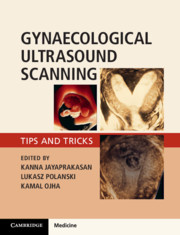Book contents
- Gynaecological Ultrasound Scanning
- Gynaecological Ultrasound Scanning
- Copyright page
- Contents
- Contributors
- Chapter 1 Get to Know Your Machine and Scanning Environment
- Chapter 2 Baseline Sonographic Assessment of the Female Pelvis
- Chapter 3 Difficult Gynaecological Ultrasound Examination
- Chapter 4 Sonographic Assessment of Uterine Fibroids and Adenomyosis
- Chapter 5 Sonographic Assessment of Congenital Uterine Anomalies
- Chapter 6 Sonographic Assessment of Endometrial Pathology
- Chapter 7 Sonographic Assessment of Polycystic Ovaries
- Chapter 8 Sonographic Assessment of Ovarian Cysts and Masses
- Chapter 9 Sonographic Assessment of Pelvic Endometriosis
- Chapter 10 Sonographic Assessment of Fallopian Tubes and Tubal Pathologies
- Chapter 11 Role of Ultrasound in Assisted Reproductive Treatment
- Chapter 12 Operative Ultrasound in Gynaecology
- Chapter 13 Sonographic Assessment of Complications Related to Assisted Reproductive Techniques
- Chapter 14 Sonographic Assessment of Early Pregnancy
- Chapter 15 Tips and Tricks when Using Ultrasound in a Contraception Clinic
- Chapter 16 Doppler Ultrasound in Gynaecology
- Index
- References
Chapter 3 - Difficult Gynaecological Ultrasound Examination
Published online by Cambridge University Press: 28 February 2020
- Gynaecological Ultrasound Scanning
- Gynaecological Ultrasound Scanning
- Copyright page
- Contents
- Contributors
- Chapter 1 Get to Know Your Machine and Scanning Environment
- Chapter 2 Baseline Sonographic Assessment of the Female Pelvis
- Chapter 3 Difficult Gynaecological Ultrasound Examination
- Chapter 4 Sonographic Assessment of Uterine Fibroids and Adenomyosis
- Chapter 5 Sonographic Assessment of Congenital Uterine Anomalies
- Chapter 6 Sonographic Assessment of Endometrial Pathology
- Chapter 7 Sonographic Assessment of Polycystic Ovaries
- Chapter 8 Sonographic Assessment of Ovarian Cysts and Masses
- Chapter 9 Sonographic Assessment of Pelvic Endometriosis
- Chapter 10 Sonographic Assessment of Fallopian Tubes and Tubal Pathologies
- Chapter 11 Role of Ultrasound in Assisted Reproductive Treatment
- Chapter 12 Operative Ultrasound in Gynaecology
- Chapter 13 Sonographic Assessment of Complications Related to Assisted Reproductive Techniques
- Chapter 14 Sonographic Assessment of Early Pregnancy
- Chapter 15 Tips and Tricks when Using Ultrasound in a Contraception Clinic
- Chapter 16 Doppler Ultrasound in Gynaecology
- Index
- References
Summary
When performing ultrasound examination, there are times when the views are not optimal. This chapter will highlight such situations and help one to recognize them. This chapter aims to describe the findings and possible suggestions, which may help to optimize the ultrasound imaging. Following the basic principles as described in Chapters 1 and 2 will go a long way to helping with difficult cases, and these will be reinforced in each scenario described below. While reporting the findings, acknowledging the limitations of the scan findings is very important, especially as many clinicians will be managing the patients on the basis of the report only.
- Type
- Chapter
- Information
- Gynaecological Ultrasound ScanningTips and Tricks, pp. 30 - 40Publisher: Cambridge University PressPrint publication year: 2020



